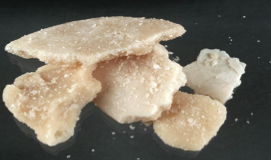Levamisole-Laced Cocaine Makes for a Novel Vasculitis
What clinical findings suggest levamisole toxicity?
Cocaine abuse can be dangerous, deforming, and fatal. Among the host of adverse effects are an association with hepatitis C followed by cirrhosis, as well as aortic dissection, seizures, interstitial lung disease, and vasospasm and thrombosis with lethal consequences, including ischemic bowel, digital, or limb necrosis, and myocardial infarction. Recently, a novel vasculitis has been added to this growing list of serious complications.
 AN INCREASINGLY COMMON COMPLICATION OF COCAINE USE
AN INCREASINGLY COMMON COMPLICATION OF COCAINE USE
As much as 47% to 60% of cocaine seized at US borders is mixed with levamisole.1 The choice of the antihelminthic-immune modulator as a mixing agent has yet to be completely explained. At present, levamisole use in the United States is limited to veterinary medicine; it is prescribed for the eradication of nematodes.1
In the 1970s, levamisole’s immunomodulatory effects were employed to treat rheumatoid arthritis, nephrotic syndrome, and colon cancer.2 It was removed from the market because it induced hypersensitivity reactions and agranulocytosis.2 Today, its troublesome immunomodulation has resurfaced in a novel cocaine-levamisole-combination vasculitis.
Multiple studies1-3 have associated cocaine-levamisole in all its forms (inhaled, intravenous, smoked as crack) with a severe vasculitis that includes palpable purpura with a predilection for the ears, positive anti-neutrophil cytoplasmic antibody (ANCA) and anticardiolipin/lupus anticoagulant titers, low-titer antinuclear antibody positivity, and agranulocytosis, as well as other less common findings (such as hypocomplementemia). Some patients have required skin grafts as therapy.
No consensus has been reached on appropriate therapy other than the obvious cessation of cocaine. Corticosteroids have been used, but there are no data to document their efficacy.
WHEN TO SUSPECT COCAINE-LEVAMISOLE VASCULITIS
The syndrome requires a clinical diagnosis with a high index of suspicion when the findings are present. Although the urine of persons with this variety of vasculitis may test positive for cocaine, the specimen must be sent quickly for testing because cocaine is present in urine for only 2 to 3 days. Urine toxicology is usually not diagnostic for levamisole because the drug has only a 5.6-hour half-life.3 In fact, most clinicians suggest that the presence of levamisole in toxicology specimens is not necessary for the diagnosis.
Therefore, a constellation of findings—vasculitis with rash/palpable purpura, especially involving the earlobes, antibody titers associated with other vasculitides such as Wegener’s or lupus (ANCA and anticardiolipin)—warrants a careful drug history. The increasing frequency with which this vasculitis is reported in the literature, coupled with the continued adulteration of cocaine with levamisole, predict that this syndrome will become even more common.
1. Poon SH, Baliog CR Jr, Sams RN, et al. Syndrome of cocaine-levamisole-induced cutaneous vasculitis and immune-mediated leukopenia. Semin Arthritis Rheum. 2011;41(3):434-444. Epub 2011 Aug 24.
2. Ullrich K, Koval R, Koval E, et al. Five consecutive cases of a cutaneous vasculopathy in users of levamisole-adulterated cocaine. JCR. 2011;17:193-196.
3. Gross RL, Brucker J, Bahce-Altuntas A, et al. A novel cutaneous vasculitis induced by levamisole-contaminated cocaine. Clin Rheumatol. 2011;30:1385-1392.


